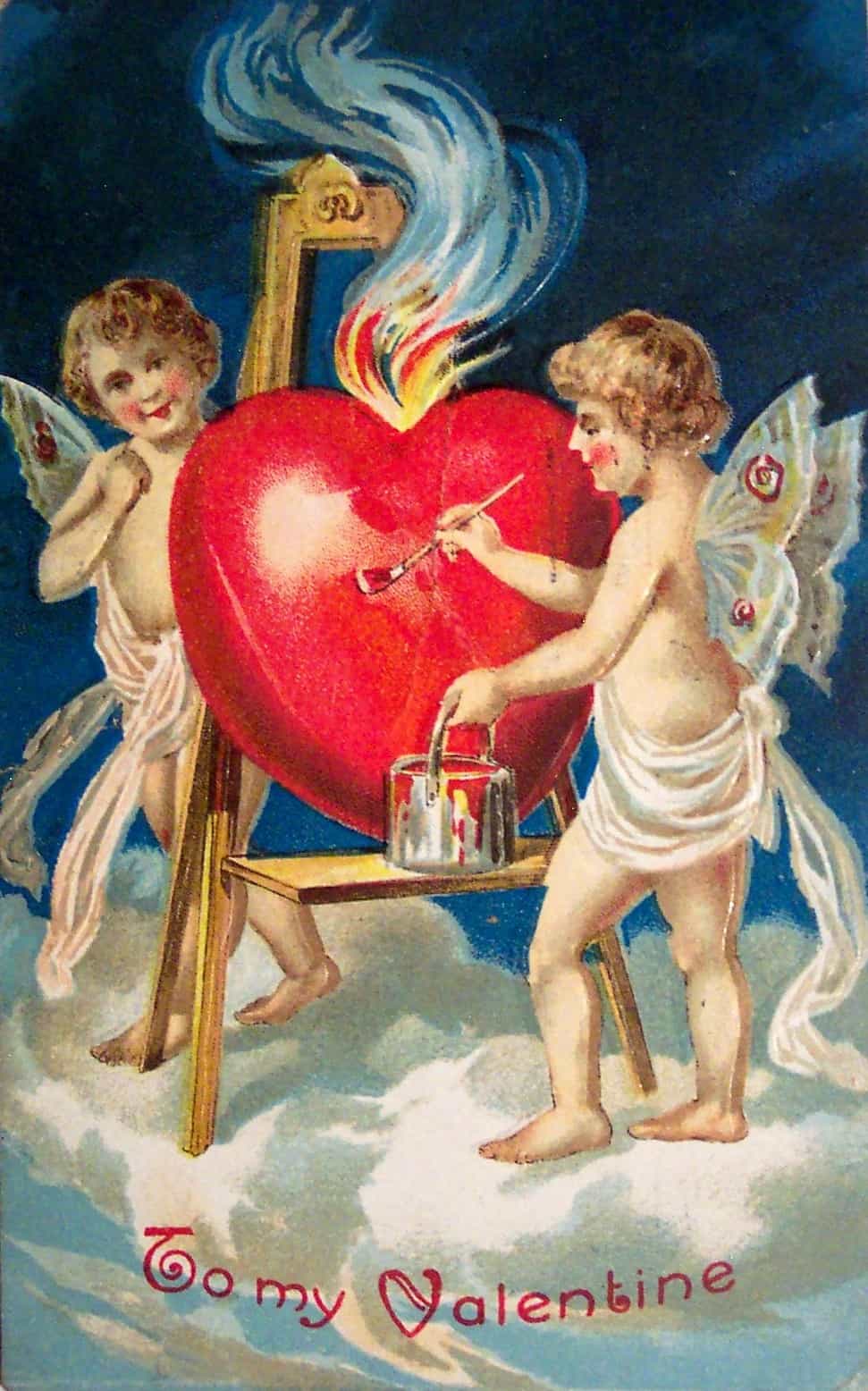
The Unruly History of Saint Valentine’s Day
St. Valentine’s Day is in every way an odd holiday: originally honoring a martyr who chose death rather than renounce his faith, it transformed into a saccharine secular holiday of self-indulgence. The story of how we got from commemoration of martyrdom to candy hearts and Hallmark cards is itself fascinating and reveals much about how we have always twisted history to suit our immediate needs.
We can see this distortion of history on social media where a post regularly making the rounds “explains” that St. Valentine’s Day is simply a pagan holiday in flimsy Christian cover (there seems to be a secular humanist template for “debunking” Christian holidays as paganism warmed over – Christmas, Easter, St. Valentine’s – all treated to poor historical interpretation by non-scholars who can’t read ancient languages). This “fact-check” claims that the Roman pagan festival of Lupercalia was “stolen” by the Catholic Church and transformed into St. Valentine’s Day. This idea goes back to rationalists of the 18th century, including Fr. Alban Butler who compiled a Lives of the Saints and Francis Douce. Both sought to trace continuity of contemporary practices back to pagan antiquity and forced arguments when documentation was lacking. Lupercalia was a Roman fertility festival celebrated mid-February that featured young male aristocrats running naked through the streets whipping women with cords as they passed (fans of Shakespeare may remember this festival in Act I of Julius Caesar). The idea is that in AD 495, Pope Gelasius I substituted St. Valentine’s Day for Lupercalia, in effect allowing the people to maintain their pagan celebrations while removing the pagan name. This idea is nonsense based on poor interpretation of documents. Gelasius I did suppress the Lupercalia: the Roman senator Andromachus had complained that an epidemic in Campania was the result of Christian suppression of the holiday and this “traditional” Roman demanded that it be reinstated to ward off disease. Gelasius I responded by pointing out that the Lupercalia was not intended to suppress pestilence, it was intended to increase fertility, and so if Andromachus wanted to depend on pagan superstition, he should at least get his superstitions right and that further, if Andromachus wanted to celebrate in the traditional manner, he was certainly welcome to run naked through the streets of Rome himself (William Green, “The Lupercalia in the Fifth Century”; Roger Pearse, “The Abolition of the Lupercalia”). The belief that Pope Gelasius I was involved in instituting St. Valentine’s on February 14th is simply a bad interpretation of historical documents. The basis for this claim seems to be that St. Valentine is commemorated on February 14th in an early manuscript known as the Gelasium sacramentarium. This fact was interpreted in a context-free environment to suggest that Pope Gelasius instituted the feast of St. Valentine on February 14th. This was based on the belief that this manuscript is the first recorded mention of the feast day. It isn’t. The Gelasius sacramentarium is a mid-7th century manuscript which includes changes instituted by Gregory the Great in 604 and is only associated with Gelasius because of a passing reference in the Liber pontificalis that Gelasius ordered the creation of a new sacramentary, leading some to believe (hope) that this sacramentary was the one referred to. The inclusion of material from Gregory the Great slams the door shut on that theory (See Roger Pearse, “Sacramentarium Gelasianum – The Gelasian Sacramentary”).
One can read through the early medieval lives of St. Valentine and not find anything approaching the modern take on the saint. The earliest accounts mention miraculous healings and martyrdom by beheading, but include nothing of writing letters or blessing couples. Nothing in the earliest sources speak even of letters, much less of physical love. From seemingly nowhere in late 14th century England, St. Valentine’s Day became associated with romantic love. Geoffrey Chaucer’s Parliament of Fowls (1381 or 1382) seems to be the first work in which St. Valentine suddenly become associated with springtime coupling of birds. Written probably to celebrate the contracted marriage of King Richard II and Anne of Bohemia (they wed Jan, 1382), the poem is a dream-vision in which male birds of eagles come together to argue for the right to mate with a particular female eagle and each sets forth his “case” as to why such a coupling would be licit. The work refers to the tradition of “courts of love”, which in literature resolved such questions about love that crosses social hierarchies. References to actual courts under Eleanor of Aquitaine and Marie of Champagne are of dubious historicity, but very well may have happened as a half-serious courtly pastime. The poem is set in a beautiful meadow, with trees and flowers in full bloom and greenery. Chaucer mentions repeatedly that this occurred on St. Valentine’s Day, when birds choose their mate – his repetitious insistence on this “tradition” has the feel of a previously unknown concept being introduced as traditional practice.
Scholars have attempted to justify how February 14th fits the setting of lush spring verdure Chaucer describes; the results have generally not been convincing (Jack Oruch, “St. Valentine, Chaucer, and Spring in February,” Speculum 56.3, 1981). A suggestion by Henry Ansgar Kelly (Chaucer and the Cult of St. Valentine. Netherlands: Lugduni Batavorum, 1986) resolves the enigma rather elegantly. what if Chaucer did not intend his St. Valentine to be St. Valentine of Rome, but rather St. Valentine of Genoa, whose feast was May 3? Chaucer had traveled to Italy twice, including Genoa, where he stayed from December 1372 to May 1373 and would have witnessed the celebration of the bishop, whose day was generally celebrated as part of the vigil on May 2. St. Valentine was commemorated in medieval Genoa at his vigil on May 2 to avoid being upstaged by the far more important feast of the Invention of the Cross, at the time celebrated on May 3. Though forgotten today, this Valentine was important to medieval Genoa. The references to full-blown spring with greenery and flowers would then make perfect sense. Further, medieval “courtly love” culture already had a day given to romantic celebration, May 1. While this possibility would almost seamlessly merge St. Valentine with the already existing celebration of romance the day before, we should expect anyone in England not familiar with obscure Genoese saints to assume that Chaucer meant the familiar St. Valentine whose feast fell on February 14th.
It is speculation to suggest that Chaucer intended this Genoese Valentine in his poems, there is no hard textual or documentary evidence, but when dealing with medieval ideas and change, we rarely have clear evidence. This speculation rather elegantly resolves Chaucer’s otherwise bizarre association of springtime romance and a mid-February feast day. What is perhaps most striking about Chaucer’s work is that within a generation he completely transformed the significance of the ancient feast day and single-handedly created a “new” holiday that took Europe by storm. These romantic traditions were so entrenched by the 1700s that scholars felt the need to explain the jarring difference between martyrdom and love letters, resulting on the one hand with the insertion of episodes such as blessing marriages and writing goodbye letters into accounts of St. Valentine’s life and on the other hand by creating accounts of the Christianization of a pagan holiday based simply on bad historical interpretation.


Very interesting evaluation. I appreciate this view and am delighted that it has been “debunked” and shown for what it truly meas. Thanks Seth and keep up the great work of bring clarity & truth into our disordered society.